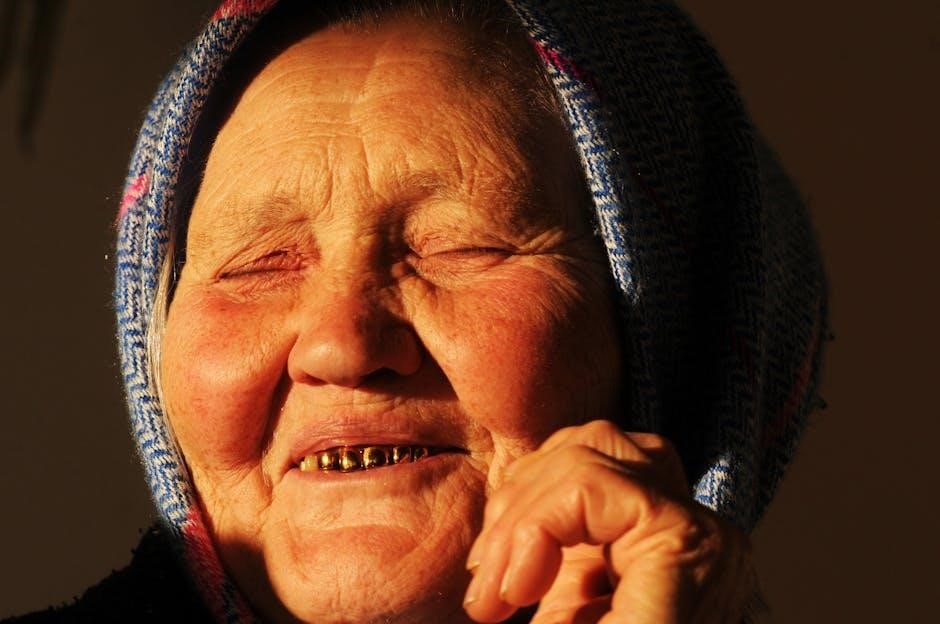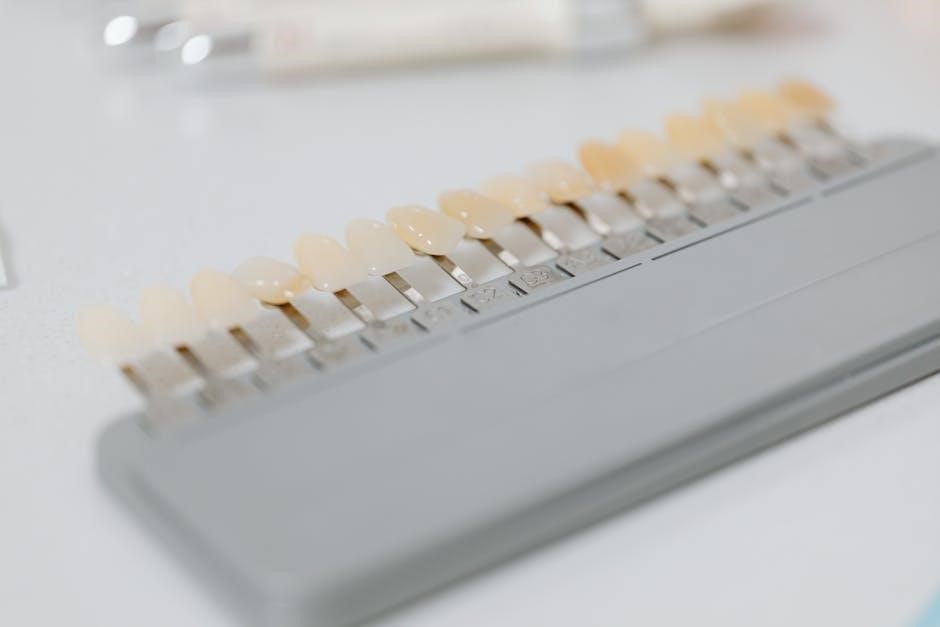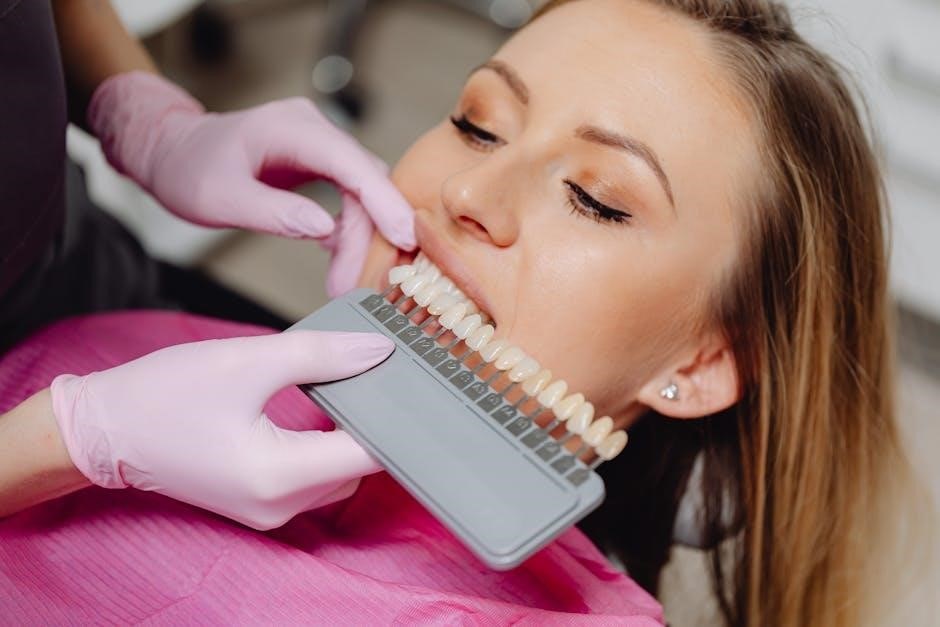Tooth shade guides are essential tools in dentistry, providing a standardized reference for matching tooth colors to ensure natural and aesthetically pleasing restorative outcomes for patients․
1․1 What is a Tooth Shade Guide?
A tooth shade guide is a standardized reference tool used in dentistry to match the color of teeth for restorative and cosmetic procedures․ It typically consists of a series of tabs or samples representing natural tooth shades, ranging from the lightest to the darkest․ These guides help dentists and technicians achieve aesthetically pleasing results by ensuring prosthetics, veneers, and other dental work blend seamlessly with the patient’s natural tooth color․
1․2 Importance of Tooth Shade in Dentistry
Tooth shade plays a critical role in achieving natural and aesthetically pleasing dental restorations․ Accurate shade matching ensures that prosthetics, veneers, and other dental work blend seamlessly with the patient’s natural teeth․ This enhances both functionality and cosmetic appeal, boosting patient satisfaction․ Additionally, tooth shade is closely linked to a person’s smile, which significantly impacts first impressions and self-confidence․ Precise shade selection is vital for creating a harmonious and visually appealing result in both restorative and cosmetic dentistry․
Components of Tooth Color
Tooth color is defined by three key components: value (lightness/darkness), chroma (saturation), and hue (basic color tone)․ These elements combine to create natural tooth shades․
2․1 Value: Understanding Lightness and Darkness
Value refers to the lightness or darkness of a tooth, ranging from brightest white to deepest brown․ It is the primary factor in shade matching, as it significantly impacts the tooth’s appearance․ Correctly determining value ensures restorations blend seamlessly with natural teeth, enhancing aesthetics․ Dentists often assess value first under controlled lighting to achieve accurate results․
2․2 Chroma: The Saturation of Tooth Color
Chroma refers to the saturation or intensity of tooth color, ranging from muted to vibrant tones․ It plays a crucial role in achieving a natural appearance, as it defines how vivid or subdued the tooth color seems․ Accurate chroma matching ensures restorations blend harmoniously with adjacent teeth․ Dentists use shade guides to assess chroma after determining value, ensuring the selected shade aligns with the patient’s natural dental aesthetics for optimal results․
2․3 Hue: The Basic Color Tone
Hue represents the basic color tone of a tooth, such as red, yellow, or blue․ It is the foundational aspect of tooth color, influencing the overall appearance․ In dentistry, determining the correct hue is critical for matching restorations to natural teeth․ Shade guides categorize hues to help dentists select the most appropriate color, ensuring aesthetic harmony․ Variations in human color perception can make hue matching challenging, requiring skill and precision to achieve accurate results․
Types of Tooth Shade Guides
Tooth shade guides vary, with the most common being the Vita Classical and digital guides․ They provide standardized references for accurate tooth color matching in dentistry․
3․1 Vita Classical Shade Guide
The Vita Classical Shade Guide is a widely used tool in dentistry, offering a standardized range of tooth shades categorized from A1 to D4․ It helps dentists match the color of natural teeth accurately for restorations, ensuring both functional and aesthetic results․ This guide is particularly valued for its simplicity and effectiveness in clinical settings, making it a cornerstone in shade selection processes․
3․2 Digital Shade Guides
Digital shade guides utilize advanced technology to measure tooth color accurately, offering real-time analysis and improved precision․ These tools often include spectroscopy or digital imaging, providing objective data to enhance shade matching․ They reduce subjectivity and variability, ensuring consistent results․ Digital guides also allow for better documentation and communication with labs, making them invaluable in modern dental practices for achieving optimal aesthetic outcomes․

Factors Affecting Tooth Shade Selection
Natural tooth color variation, staining, and the impact of restorative materials are key factors influencing shade selection, ensuring a natural and aesthetically pleasing dental outcome․
4․1 Natural Variation in Tooth Color
Natural variation in tooth color arises from differences in enamel thickness, dentin color, and translucency․ These variations are influenced by age, genetics, and oral health, making each tooth unique․ Understanding these natural differences is crucial for accurate shade selection, as they determine the final aesthetic outcome of dental restorations․ Dentists use shade guides to account for these variations, ensuring restorations blend seamlessly with surrounding teeth for a natural appearance․
4․2 Staining and Discoloration
Staining and discoloration affect tooth shade selection by altering the natural color of teeth․ Extrinsic stains, caused by food, tobacco, or poor hygiene, occur on the enamel surface, while intrinsic stains, from trauma, medication, or aging, penetrate deeper into the dentin․ These variations complicate shade matching, as they may require additional masking or specialized techniques to achieve a natural appearance․ Dentists must account for these discolorations when using shade guides to ensure optimal aesthetic results․
4․3 Restorative Materials and Their Impact
Restorative materials significantly influence tooth shade selection․ Materials like porcelain, composite resin, and ceramic have distinct optical properties that affect color perception․ For instance, porcelain veneers may require precise shade matching to blend seamlessly with adjacent teeth․ The translucency and opacity of these materials can alter the final appearance, making it crucial to consider their impact during shade selection․ This ensures that the restorations look natural and harmonize with the patient’s existing dentition, achieving both functional and aesthetic success․

The Shade Matching Process
The shade matching process involves determining value, selecting chroma and hue, and verifying the final choice to ensure accuracy and aesthetic satisfaction for the patient․
5․1 Initial Assessment and Consultation
The initial assessment involves a thorough examination of the patient’s teeth to evaluate their current shade, shape, and any discoloration․ The dentist considers the surrounding teeth and gum tissue to ensure harmony․ During the consultation, the patient’s preferences and expectations are discussed to align the aesthetic goals․ This step is crucial for understanding the patient’s needs and setting realistic outcomes․ The dentist then makes preliminary notes to guide the shade matching process effectively․ This collaborative approach ensures a personalized and satisfactory result․
5․2 Determining Value
Determining value involves assessing the lightness or darkness of the tooth, which is the most critical aspect of shade matching․ Using a shade guide, such as the Vita Classical, the dentist compares the tooth to standardized tabs under controlled lighting․ This step ensures accuracy, as value dictates the overall brightness and is foundational for achieving a natural appearance․ Accurate value determination is essential for creating restorations that blend seamlessly with adjacent teeth, enhancing both function and aesthetics․
5․3 Selecting Chroma and Hue
After determining the value, chroma and hue are selected to refine the tooth’s color․ Chroma refers to the saturation, or intensity, of the color, while hue denotes the basic color tone, such as yellow or gray․ The dentist uses the shade guide to match these aspects, ensuring the restoration harmonizes with the patient’s natural teeth․ This step requires careful observation and communication with the patient to achieve a result that meets aesthetic expectations and maintains dental harmony․
5․4 Verification and Final Selection
Verification involves comparing the selected shade under various lighting conditions to ensure accuracy․ The dentist may use mirrors to evaluate the tooth’s appearance from different angles․ Final selection is confirmed when the shade blends seamlessly with the patient’s natural teeth․ This step ensures the chosen shade aligns with the patient’s aesthetic expectations and dental structure, providing a visually pleasing and natural-looking outcome for restorative procedures․ Patient input is often sought to achieve satisfaction and consensus․
Challenges in Shade Matching
Shade matching is complex due to subjective color perception, varying lighting conditions, and patient expectations, requiring precise communication and advanced tools for accurate results․
6․1 Subjectivity in Color Perception
Subjectivity in color perception is a significant challenge in shade matching․ Dentists and patients may perceive colors differently due to individual variations in vision and lighting conditions․ Achieving consensus can be difficult, as personal preferences and biological factors influence color interpretation․ This subjectivity requires skilled communication and advanced tools to ensure accurate and aesthetically pleasing outcomes in dental restorations․
6․2 Lighting Conditions
Lighting conditions significantly impact tooth shade matching accuracy․ Variations in ambient light, such as natural daylight versus artificial sources, can alter color perception․ Consistent lighting is crucial for reliable shade selection․ Dental professionals often use specialized lighting, like LED units, to minimize discrepancies․ Poor lighting can lead to mismatches, emphasizing the need for standardized conditions during the shade-matching process to ensure precise and visually appealing outcomes for patients․
6․3 Patient Expectations and Communication
Patient expectations play a crucial role in tooth shade matching, as satisfaction often depends on perceived aesthetics․ Effective communication between dentist and patient is essential to align expectations with achievable outcomes․ Understanding patient preferences, such as desiring whiter or more natural-looking teeth, helps guide shade selection․ Open dialogue ensures mutual understanding, fostering trust and collaboration․ Addressing concerns and explaining limitations can manage expectations, ultimately leading to more satisfying results for both parties involved in the dental treatment process․

The Role of Shade Guides in Cosmetic Dentistry
Shade guides are vital in cosmetic dentistry for achieving aesthetically pleasing results, ensuring natural-looking outcomes in procedures like veneers, implants, and smile makeovers, enhancing patient satisfaction․
7․1 Enhancing Aesthetics
Shade guides play a crucial role in enhancing aesthetics by ensuring precise color matching for restorative materials․ This allows for natural-looking results in cosmetic procedures such as veneers and implants․ By aligning prosthetics with the patient’s natural tooth color, dentists create harmonious, visually appealing smiles․ Accurate shade selection minimizes discrepancies, ensuring a seamless integration of restorations with surrounding teeth․ This attention to detail boosts patient confidence, as a well-matched smile contributes significantly to overall aesthetic satisfaction and self-perception․
7․2 Ensuring Natural Results
Shade guides are vital for achieving natural-looking dental restorations by providing a standardized framework to match tooth color accurately․ This ensures that crowns, veneers, and implants blend seamlessly with adjacent teeth․ Natural results are crucial for patient satisfaction, as they maintain the appearance of healthy, uniform teeth․ By using shade guides, dentists can replicate the subtle variations in tooth color, ensuring restorations look indistinguishable from natural teeth, which is essential for both functional and aesthetic success in cosmetic dentistry․

Future Trends in Tooth Shade Matching
Advancements in AI and digital tools promise enhanced precision in shade matching; Customized solutions and real-time color analysis may redefine dental aesthetics, ensuring more personalized and accurate results․
8․1 Advancements in Digital Technology
Digital technology is revolutionizing tooth shade matching with tools like intraoral cameras and advanced software․ These systems provide precise color measurements, reducing human error and enhancing accuracy․ AI and machine learning algorithms analyze data from thousands of cases to improve shade recommendations․ Customizable digital solutions allow for tailored results, boosting patient satisfaction․ Real-time communication between dentists and labs ensures consistent outcomes, making digital technology indispensable in modern dentistry․
8․2 Customized Shade Solutions
Customized shade solutions are becoming increasingly popular, offering tailored tooth color options for individual patients․ Advanced digital tools enable precise shade matching, considering factors like skin tone and hair color․ This approach ensures natural-looking results, enhancing patient satisfaction․ With 3D printing and AI-driven systems, dentists can create unique shades that align perfectly with a patient’s smile, making restorative and cosmetic dentistry more personalized and effective than ever before․
